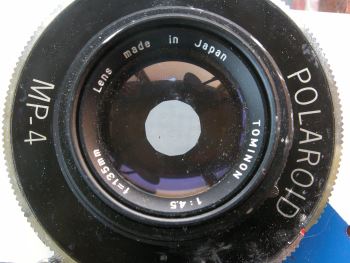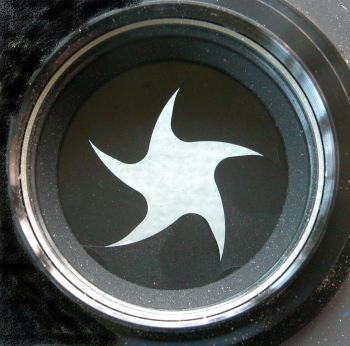Aperture, Shutter, and ISO Speeds
How they relate to each other
Aperture, Iris, and Diaphragm
The aperture is a hole in a diaphragm in the lens also known as Iris.

It controls the amount of light passing through the lens to the film or sensor.
It is normally placed near the optical centre of the lens, although it can be placed close in front or close behind fixed focal length lens.
It is described/labelled with f/ numbers for convenience. These numbers result from the division of the diameter of the hole into the focal length of the lens in inches. They are called f/ stops since they stop some of the light entering the camera. Each of the regular f/ stops listed next column lets twice or half the amount of light in of the number next to it.
There are three basic kinds of aperture. The older type known as Waterhouse Stops which are simply a hole drilled in a sheet of metal, sometimes a number of holes are drilled in a strip and this is moved through a holder to change the aperture.

Next came the leaf diaphragm, also known as the iris, which gives an infinite range of apertures, although often has click stops organised so that one can adjust it by feel.
With the advent of automatic cameras the aperture is sometimes combined with the shutter and here the shutter does not open fully if a small aperture is selected but stops opening to create the chosen aperture.
A characteristic of many digital zoom lens as opposed to movie camera zooms is that as you zoom out towards telephoto the effective aperture of the lens is reduced. Since most digital on-board flash are rather weak, conserving power since they are powered by the camera's operating battery, and they work with the aperture wide open.
This accounts for the permissible range at which the flash can be used being less, closer, when you use the tele to get a close-up. Because the lens has altered the aperture from say f/2.8 to f/4. Or at least since it works at maximum aperture when in automatic, at tele it only has f/4 instead of f/2.8 at wide. The advantage of this is that the lens can be smaller and weight less.
The Shutter and Aperture have a reciprocal relationship
In that to let the correct amount of light in to the film or sensor the aperture is closed down to match the lengthening of the time the shutter is open.
For example in what is commonly called f/8 conditions with 100ISO film there is a range of options open to the photographer whose camera has the speeds and apertures.
F/1.4 at 1/8000second
f/2 at 1/4000 second
F/2.8 at 1/2000 second
F/4 at 1/1000 second
F/5.6 at 1/500 second
F/8 at 1/250 second
F/11 at 1/125 second
F/16 at 1/60 second
F/22 at 1/30 second
Shutter
The Shutter is the device that controls the duration that light is permitted to enter the camera.

In the early days of photography this was achieved by removing a lens cap for the duration of the exposure, often several minutes even in bright conditions. The technique is to remove the cap and hold it in front of the lens for ten to fifteen seconds while the camera stops vibrating on it's tripod or other firm support. At the end of the required exposure the cap is replaced and the film changed. This technique can be used to make multiple exposures with the modern camera if the shutter can be locked open using the 'B' or 'T' settings found on some shutters. The lens being capped between the exposures by holding a black card in front but slightly away from the lens ....for firework displays is an obvious use.
Following this was the Roller Shutter with a blind travelling across the front or behind the lens with a slit in it ... something akin to the Waterhouse Stop. This was developed into the Focal Plane shutter as we know it today where there are two blinds, cloth or metal, just in front of the film or sensor. The gap between the first one exposing the film and the second one following it and closing off the light from the film/sensor gives the exposure required.
When using electronic flash which has duration of 1/1500 second upwards there is a limitation on the maximum shutter speed you can use. That is the speed at which the first blind has reached the edge of the filmgate/sensor and the second blind has not started to cover up. With old Leica's this was 1/20 and 1/30 but modern SLRs can be between 1/60 and 1/250 and occasionally faster. The speed is usually marked with an 'X'. You can use slower speeds but not faster.
The Compur shutter is like an iris which opens and closes and can be synced for flash to it's fastest speed. It is of necessity placed in the middle of the lens assembly so you need one for each different lens. The Polaroid lens on the left has a compur type shutter
B and T
With B the shutter opens when you press the trigger and closes when it is released.Less common these days is T where you press to open and then press to close.
When buying a cable release go for one with a locking mode so that you can lock the shutter open when using B for the 'capping' technique mentioned above.
The shutter found in digital pro-sumer cameras and point-and-shooters uses an electro/mechanical system and often will sync up to the fastest shutter speed in the camera.
Check your manual.
ISO ----- Film and Sensor Speeds
ISO numbers look like shutter speeds and are a indication of how fast the emulsion/sensor will react to light falling on it. They are set by the manufacturer and are an indication, usually a good one, of how to rate the film. But depending on how the camera is used, and the result required by the photographer they will be varied following tests. Black and White film workers often reduce the ISO rating to get good detail in the shadows whereas a digital worker could increase the sensor speed in effect by working at minus one or two EV to deliberately under-expose so that highlights do not burn out to white or nothing.
The higher the number the less light the film/sensor requires to record the scene.
The drawback of faster speeds is an increase in the size of grain, the granules of sensitive material comprising the emulsion, with a similar effect called Noise in digital.
The faster the emulsion the larger the grain needs to be. Similarly the larger the pixels of the sensor are the easier it is to capture the light needed for a noiseless image. The advantage of the whole frame [36x24mm] sensor of some DSLRs as opposed to the5/8" sensors of the pro-sumer.
The pro-sumer however can take a second 'black' exposure corresponding to the actual exposure and compares the pair to pick up and remove noise.
But of course this increases the delay between shots. Everything is a compromise
F/32 at 1/15 second
F/45 at 1/8 second
F/64 at 1/4 second
Here shutter speeds are rounded to those commonly available/marked. Automatic film and digital cameras come up with intermediate f/ stops and shutter speeds organised by their computer.
It is useful to get to recognise which number is which .... So 5.6 is an aperture but 90 is a shutter speed since there is often limited space for the markings.
The digital camera comes up with interesting figures like 7.1 for an aperture and 178 for a shutter speed, although my camera has the prefix and suffix in it's display.
On older cameras made on the European continent you could find f/ stops such as ----- f/2.3 - f/3.2 - f/4.5 - f/6.3 - f/9 - f/12.5 - f/18 - f/25 - f/36 which are derived the same way as the Anglo-American-Japanese system most commonly found.
The maximum aperture of a lens often does not conform the regular numbers so you get f/3.5 or f4.5 lens etc.
Noise arises out of the amplification of the signal from the sensor and some cameras are better than others in this respect. Except when you are working in RAW the camera is designed to modify the signal in respect to contrast, saturation, and noise. This is more so in Point and Shoot cameras, and less so in Pro-sumers and DSLR where there is usually provision made for the operator to adjust the settings.
Often people 'stepping up' from P&S to Pro-sumer or DSLR are disappointed with their results not appreciating that the better camera is arranged to give less modulated results assuming that the file will be treated in an editing programme before being printed or otherwise displayed.
Unlike film where a different emulsion is designed for the faster ISO speed with digital it is a question of amplification of the signal from the same sensor and this can either be done in the camera or in editing with often little difference in the result.
So a pro-sumer with only 400ISO can be effectively worked at 1600ISO by working in manual and under-exposing by two stops and lifting in editing with the 'levels' or 'curves' tools.